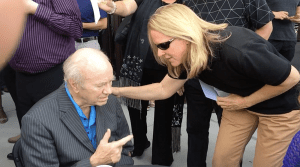
Theo Wujick
The first time I saw Theo Wujick was around 1977 or 1978. He was dancing alone at punk bar, the Miss Lucky Club on Nebraska Avenue. He wore gold spray painted boots. The rumor was he slept in his office and showered at a USF pool facility. I followed his work at a respectful distance until we became friends years later after many mutual lunches (separate tables) at our favorite lunch spot, Trang Viet. He was warm, talented and knew how to enjoy himself while carving out the solitary time he needed to focus on his work.
After Theo left us behind on earth, I had the incredible fortune to be invited to a private visit to his studio. Thank you Susan! The sheer quantity of work was numbing. There were huge, beautiful works, which must have taken months to conceive and complete. There were intimate paper cutouts of horses with articulated arms and legs. There were bits and pieces of his thoughts. Composites of his life painted to abstraction. I was moved by his focus. He knew how to play but he also knew how to work.
You can see a collection of his work at the St. Petersburg Museum of Art (MFA).
https://www.tampabay.com/arts-entertainment/the-art-of-ybors-late-punk-prince-theo-wujcik-lives-on-at-the-mfa-20190503/

James Rosenquist
“You live till you die, and that’s the end of it. What good is your legacy when you are dead? I worry about being alive, selling work, having fun, moving and doing things when I am alive.”
I met James Rosenquist during Theo Wujick’s memorial May 10th, 2014 at the Contemporary Art Museum – USF. He shared something I will never forget, his reason for transplanting to Florida was to eliminate distraction. I lived in Manhattan in the mid-eighties, I know what he means. The constant draw of the city called me from my tiny ground floor brownstone to a world that served up some of the best cinema I’ve ever seen – and that was just experiencing life while walking down the street.
Rosenquist utilized his commercial art experience to create fine art. He was one of several at the time to explore the role of advertising and consumer culture in art and society. Today, his images seem almost “everyday” as the line between art and advertising are blurring almost beyond recognition. We are no longer told what we need to buy. The spokesperson in the latest form of advertising is you. It’s as if there are different “yous”, the one who believes a successful life is a collection of things that fill the hole created by the distractions in life. Then there is the “you” who given the chance, dreams to take a minute to experience the exceptional parts of life you traded for working most of your waking hours. You make excuses for not living. You delay life until you discover you delayed life.
This new story-based ad is an example of how far into our psyche contemporary advertising is willing to go:
https://www.youtube.com/watch?v=IlLflZS0g10&feature=youtu.be
All it takes is a $50,000 investment in a luxury car to make your hamster wheel misery take a back seat.
I used to be paid handsomely to maneuver consumers in one direction or another. One day as I was racing to “another appointment” when I caught myself driving down the highway with the urgency of a life or death mission, hands gripping the wheel, zooming around obstacles that prevented me from my goals. I spent so much time distracted from life, I forgot to listen to birds, to see the bark on trees.

I asked myself how many more pairs of shoes should I own?


